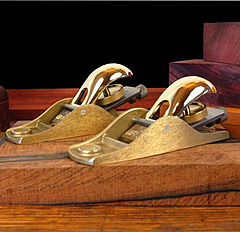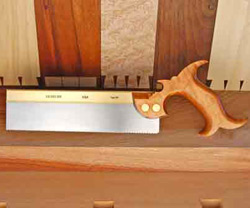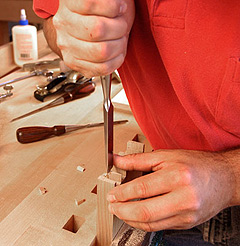
Listen in at any woodworkers’ guild meeting and, when the talk of one’s favorite hand tools turns to unabashed boasting, odds are that someone is dropping the name Lie-Nielsen. Long regarded as the ne plus ultra of hand tools, Lie-Nielsen planes and saws are highly sought-after by serious woodworkers, and are adored by the “Neanderthals” who prefer hand tools to those with cords. When you are ready for the very best, someone will inevitably steer you to the company founded by Thomas Lie-Nielsen.
Tom created his company 25 years ago to once again make top quality hand tools here in the U.S., something he saw as being in decline. Today, they offer over 50 types of planes, saws, chisels, and spokeshaves. Their line centers on revivals of old but useful designs, such as vintage Stanley planes, crafted with improved materials and methods.
“One of the reasons I started this,” Tom told me, “was to make such tools readily available and orderable. We’ve done that, but along the way we have made significant improvements in everything from the quality of flatness tolerances and casting materials, to thicker cryogenically-treated tool steel blades and an improved chip breaker design.” As a result, most people prefer using Lie-Nielsen tools even over the original designs that inspired them.

“My most serious competition comes not from another contemporary maker, but rather vintage Stanley tools,” Tom explained. “Unfortunately, old tools are hard to come by, and often require large degrees of tuning up. My idea was to make great tools right here in the U.S. so the average woodworker could obtain them. To that end, I’ve deliberately tried to steer away from the collector’s market. I want my tools being used. For example, I don’t number tools, do limited editions or sign tools. I try to make and market eminently practical tools so that they will be used.”
Though the best woodworkers readily understand that, Tom feels that top-notch tools may be even more important for beginners. “Good tools help you do the job,” he reminded me. “You don’t want tools working against you, which is often what discourages beginners. They think it is them when it is really the tool.”

That’s a realization that Tom developed early on, and one that was reinforced over a long career working with tools. “I grew up around my father’s wooden boat building shop in Maine, and worked there growing up. After college I worked for tool dealer Garrett Wade for three years. It was a great way to get to know all facets of the mail order business, but it also got me interested in tools. Before that, I was interested in woodworking.
“Customers were always asking for old tools that were no longer made, and saying things like ‘they don’t make them like they used to’ in spite of the fact that the technology was certainly available. The problem was that larger companies were aiming at a more price-conscious market. While there were several people who were making good quality tools as a cottage industry, delivery was always sporadic. I wondered why someone couldn’t make high quality tools and still offer reliable delivery.
“I got together with Ken Wisner, a brilliant machinist more interested in development than production, and took over manufacture of one of his redesigns of a specialized Stanley plane. I bought a milling machine and taught myself how to use it, then spent my first decade in business teaching myself what I needed to learn.” The two made a couple hundred “no name” planes before adding the Lie-Nielsen brand name. “That first year we only made an edge trimming block plane. After that came a skew block plane and a low angle block plane. All this took place in a small, 400-square-foot woodshed,” Tom recounted, “and I assembled the tools in my kitchen.”
Meanwhile, Tom and his wife were living on a working farm, raising and selling blueberries, milking cows, and tending chickens and sheep. That was the source of income that allowed the growth of the tool company. “I got divorced in 1986, sold the farm, and moved into a 2,500-square-foot abandoned icehouse in Warren, Maine where I both lived and worked. There I started to acquire serious machinery and grow the business. Within the first year, I hired my first part-time employee, started adding more tools to the line, and expanded my capacity to build.”

Frustrated with outsourcing the specialized manganese bronze castings used for many of his planes, he set up his own foundry in 1990. “That lasted about six years before I found a foundry that was both capable and willing to do my work. They do all the bronze; the iron is cast in a different family-owned foundry.” Although more expensive, Tom uses the bronze alloy because it is heavy, does not rust, and is beautiful. “The alloy we use is wear resistant and won’t break if you drop it,” Tom explained. “Larger tools are made in iron because of the weight and cost.”
A decade later, he doubled the size of his building, and is currently adding another 10,000 square feet of manufacturing space. Today, some 70 employees turn out dozens of different products, including planes, chisels, saws and even workbenches. “We’re working on a shave horse design with Brian Boggs that will be available this summer,” Tom added.
Lie-Nielsen tools are available directly from their web site, but you’ll also find them at most woodworking shows, where you can get your hands on them. “We’ve also been producing our own videos for the past four years,” Tom added, “in an effort to educate our customers so they can get the most out of our tools.”
It will come as no surprise that tools of this quality are not cheap; planes range from 65 to almost 500 dollars; saws go from about 100 to 200 dollars, and chisels start at 50 dollars. There are good reasons for that. “The materials we use are not cheap,” Tom said. “There is a lot of labor, all of it American, that goes into making these tools. The bottom line is that they may be expensive, but they offer good value considering what they are and how they will perform.”
“There’s another element to buying tools of this quality,” Tom continued. “Treating yourself to a really nice tool advances your woodworking skills and will be pleasurable every time you use it. There’s a pride of ownership that comes from the way it looks, works and feels in your hand; it says you are good enough to deserve a really nice tool for your woodworking. That’s why we’re making tools with better materials and tolerances than have ever been made before, with designs that are improvements on traditionally proven ones.”
For Tom, there’s a very personal commitment behind this effort. “We feel that we make the best hand woodworking tools available. We do what it takes to do a top quality job, and make tools that actually work when you buy them instead of ones that you must spend time tweaking before they perform well. I see no point in doing anything less.”





